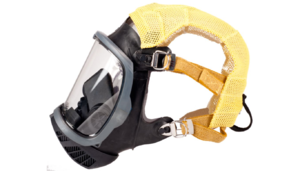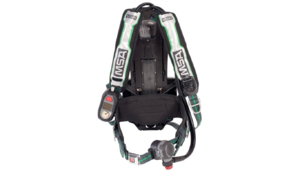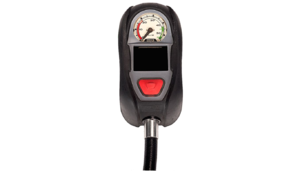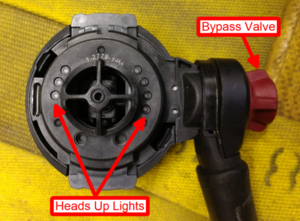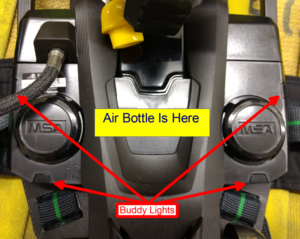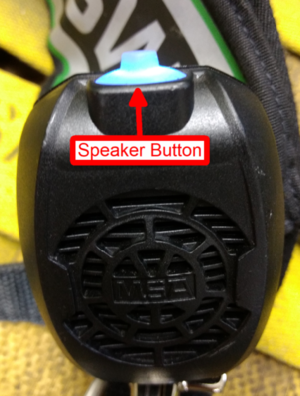SCBA
As of March 2017 MEFD uses MSA G1 SCBA. Each firefighter is provided their own mask, with packs and bottles available on apparatus and at each station. All bottles in use are 4500 psi, 45 minute rated, composite cylinders.
The Mask and Pack operators manual is available here: http://bit.ly/2R18tmf
G1 Mask
- Each mask has an engraved id number on the front, just above the view window. A list linking mask with firefighter is posted at each station.
- G1 masks contain no electronics and can be submerged for cleaning.
Heads Up Display
Inside the mask there are a series of lights that provide key information about the state of your air system.
Pressure Indicators
- 4 Green LEDs = 75-100%
- 3 Green LEDs = 50-74%
- 2 Yellow LEDs = 36-49%
- 1 Red LED = 0-35%
G1 Pack
- Buddy lights
- Louder PASS alarm
- Adjustable lumbar support
- Requires 6 C batteries in battery pack. A replacement battery pack is on each engine. In addition the packs will continue to supply air without any batteries.
- Low air alarm set to sound at 1750PSI.
Conserving Air
The air in your SCBA cylinder is limited. Even though we may refer to them as '45 minute' bottles, the actual productive work time is much less. Two main factors limit usable time:
- You must leave the IDLH before your low air alarm sounds.
- Firefighting is hard, physical work. And you are doing that work in heavy PPE, in hot conditions. You will use more air than you think you will doing even simple tasks.
There are three main things you can do to conserve your air.
- Don't go 'on air' until you need it. Don't be reluctant to use your air when you are around smoke or other toxins, but don't suck down your bottle waiting around in areas with breathable air.
- Relax. The more excited you are, the more your adrenaline is pumping, the more oxygen you'll need.
- Practice skip breathing or another similar technique to get as much oxygen out of the air you have.
Inspecting an SCBA Pack
SCBA must be inspected after every use and during regular maintenance nights. Record the inspection in the SCBA Inspection binder found at each station.
A full SCBA inspection:
- Start with the pack air bottle down.
- Record the Asset Tag number on the sheet.
- Extend all the straps.
- Inspect the pack, shoulder straps, hip belt, and buckle for damage.
- Set the hip belt to the middle position.
- Flip the pack over and spread out the straps so that the regulator and controller are free.
- Inspect the straps, bottle, control, regulator, hoses, connectors, etc for damage.
- Remove the regulator from the belt and hold it so you can see the lights.
- Make sure the bypass valve is closed and turn on the air fully.
- The buddy lights (located on the pack along either side of the bottom of the bottle) should flash red, then yellow, then green. Note if any of the lights fail to light.
- The heads-up lights on the regulator will light. First single lights on one side: yellow, red, blue, red. Then the other side: a single red, 2 yellow, 2 green, 3 green, then 4 solid green.
- Put the regulator back on the belt.
- Check the air pressure on the bottle gauge with the gauges (digital and analog) on the control. They should be within 200 PSI of each other. Replace the bottle if it is less than 4000PSI. Record the pressure.
- Let the PASS device go into first warning and then full alarm. Shake to dismiss the alert.
- Press and hold the red button to go into manual alarm. Press the green button to dismiss the alert.
- Press the green button to change to the battery screen. Replace the batteries if they are at 2/5 or less. Record the level on the sheet.
- If this pack has a TIC, long press a green button and test the TIC. Long press again to return to the regular screen.
- Confirm that the speaker came on automatically (blue light is on). Long press the blue button to turn the speaker off. Press it again to turn it back on.
- Turn off the air fully.
- Open the bypass valve to bleed off the air. Shut it when the air stops flowing. Confirm that the low air alarm sounds as the air pressure drops.
- Double press the green button on the control to power off the pack.
- Note any issues on the inspection sheet and bring them to the attention of an officer.
- Clean the pack if it is dirty.
